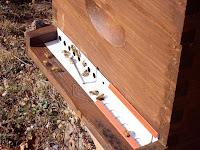

Yesterday was a beautiful day in the VA Shenandoah valley. It was bright and sunny and 60 degrees. Just after noon I went to feed the bees what I thought would be one last time since the cold weather is coming. It is the end of November after all. I figured 60 degrees I would see a few bees out for cleansing flights (aka pooping). Above on the left is the picture of the GA bees from the package I installed this spring. Not a whole lot of action going on there. On the right is the nuc I got with the Northern CA queen. Wow! Look at all the activity going on there. They were literally fighting to get in and out of the mouse guard. Bee rush hour, I suppose. Take a closer look and see if you can see the real interesting thing. Check out the girl in the picture below. Pollen?!? Where in the world are they finding pollen? Sure it was maybe 1 in 75 bees coming back with some, but still, it is November 20th!
 So I unzipped my hood and took a few steps back and tried to see where the beeline was going. I thought I got the general direction so I started walking. I eventually found 1 thistle with 3 blooms but with no bees visiting it. I also found one small aster, again with no bees. I gave up after 10-15 minutes. They could have been flying all the way across our hollow for all I know. Or I could have picked the wrong beeline. They are obviously better at finding flowers than I.
So I unzipped my hood and took a few steps back and tried to see where the beeline was going. I thought I got the general direction so I started walking. I eventually found 1 thistle with 3 blooms but with no bees visiting it. I also found one small aster, again with no bees. I gave up after 10-15 minutes. They could have been flying all the way across our hollow for all I know. Or I could have picked the wrong beeline. They are obviously better at finding flowers than I.It is an interesting thing these bees. My last article was on genetics and how the CA bees seem to be all over the place genetics-wise. If anyone has read since the beginning you may remember that from the beekeeping class they recommend getting 2 hives so you can see if they are both doing the same thing or if one is definitely stronger or weaker than the other. But that is generally two hives from the same source. This year having two hives with queens from different geographical locations has been quite interesting. While they both appeared the same during the summer, once the weather has cooled the CA bees have been consuming the sugar syrup at a greater rate, putting more weight on the hive, and are much more active during the warm part of the day. I still have to see how the winter turns out but it looks a lot like the CA bees are going to make it, at least by how active they are and how many stores they have. The GA bees are not as active and have fewer stores going into winter. Certainly the GA packages were a lot cheaper than the CA nuc but if they don't survive the winter I miss the early spring nectar flow which really cuts down on the honey harvest.




No comments:
Post a Comment
Thank you for commenting. Feel free to ask questions.